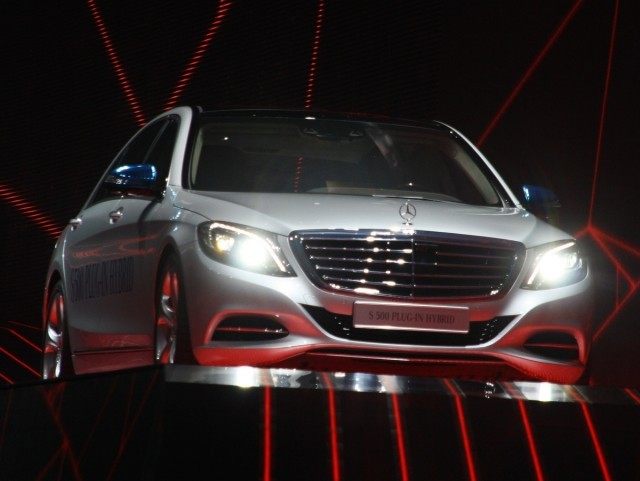Competition is about to crank up in the emerging plug-in luxury vehicle sector, with Mercedes debuting its C350e plug-in hybrid-electric sedan this September at about half the cost of Tesla Model S sedan. Mercedes will also become the first car company to deliver diesel powered full-size sedans and SUVs at discounts to gasoline equivalents.
There are strong industry whispers that Mercedes will introduce its mid-size C350e plug-in hybrid sedan at about $42,000, before $5,250 worth of federal and California incentives. At a net cost under $36,750, the plug-in diesel electric-hybrid luxury sedan will be an attractive alternative to a Tesla Model S, which is priced at $71,070 65 kWh for the low-end base model and about $85,000 to $100,000 for the premium battery and options set.
The C350e will travel an average of 18 miles in electric mode, and then it will switch to a hybrid diesel mode that will achieve about 20 percent better mileage than gas. The vehicle will go 0-60 miles per hour (mph) in 5.9 seconds and has a top speed of 130 mph.
Traditionally, the plug-in hybrid option is only available for electric/gasoline vehicles. But Mercedes is upping the competition by fully embracing a powerful and frugal hybrid dual set of electric/diesel plug-in power plants.
Many automakers offer a limited numbers of diesel models priced at a premium to their base gasoline versions. But Mercedes plans to price its E-series diesel sedan at $500 below the gasoline version, while the diesel version GL 3-row SUV is priced $1,600 below its gasoline equivalent.
Since the January 19 press debut of the Mercedes 350e, the car has been winning rave reviews from automotive industry insiders who vouch that the hype is real. The vehicle offers a long list of drive modes: from economy to sport, to electric-only, to both power plants at once.
Tesla (NASDAQ:TSLA) is a true all-electric vehicle versus the Mercedes that drives the first 18 miles on battery, before the car goes into a blended hybrid diesel mode.
The average American car is driven an average of 10,614 miles per year. Out of that figure, only about 2,000 miles are road trips. The rest are commutes, driving kids and weekends. About 60 percent of the average American trip is 6 miles. That means the Mercedes 350e can handle the vast majority of round-trips on a single charge. For the 2,000 mile round-trip to grandma’s house, diesel power would be much more ideal than pulling over for a two-hour charge in a Tesla, if you can even find a station on the road.
Tesla is promising the $35,000 Tesla Model 3 mid-size sedan will start delivery by 2017, but volumes will not be available until at least 2018. However, analyst Anton Whalman recently commented, “It has now taken Tesla over three years since the February 2012 introduction of the Model X [SUV], and there is still no Model X in customer hands, Mercedes’ time-to-market advantage is likely to grow considerably beyond two years.”
Wahlman believes Tesla has four major cost disadvantages to Mercedes: 1) Mercedes has global purchasing power for components; 2) Mercedes makes its car in Alabama, versus high cost Silicon Valley, California; 3) Mercedes’ technology does not rely on a 1,000-pound battery pack to be able to drive longer distances; 4) Mercedes can afford to cross-subsidize from its other car, bus and truck operations.
Mercedes plans to introduce the C350e in 2015 and to have ten plug-in hybrid models on the marker by 2017. The models will include multiple sedans and several SUVs across a wide set of price ranges up to over $100,000.
The Tesla Model S is a beautiful design and engineering feat. But with Mercedes on the scene, the Tesla novelty is about to face its first major industry challenge.
Photo: file (shown: Mercedes S 500)

COMMENTS
Please let us know if you're having issues with commenting.